Hobby Boss 1/48 F4U-4 (early)
|
KIT #: |
80386 |
|
PRICE: |
$55.99 SRP |
|
DECALS: |
Two options |
|
REVIEWER: |
Tom Cleaver |
|
NOTES: |
Aeromaster 48-100
“Air War Over
Korea”
used for the model. |
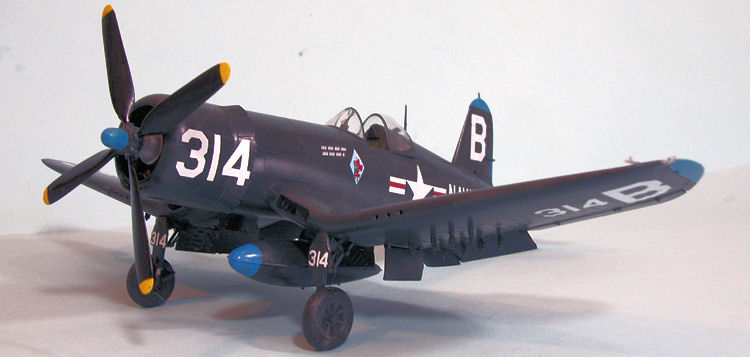
The ultimate
Corsair to see service in the Second World War was the F4U‑4.
The XF4U‑4 first flew on
April 19, 1944,
followed quickly by four other prototypes.
The airplane was powered by the R2800‑18W, an excellent high‑altitude
engine that gave the airplane outstanding climb and speed performance up to
35,000 feet, which was what was needed for a fleet defense interceptor, and was
equally capable as a fighter‑ bomber, equipped with two 1,000 lb. bombs or eight
5 inch HVARs. With a top speed of
446 mph at 26,000 feet ‑ a 50 mph improvement over the F4U‑1D at the same
altitude (the F4U‑1D's best rated altitude was 20,000 feet), the F4U‑4 was
competitive with any other fighter in the world.
Production models began arriving in late 1944, and 1,856 had been
delivered by the end of the war in August, 1945.
The last of 2,056 was delivered in April 1946, and the F4U‑4 became the
standard fighter‑bomber of both the Navy and the Marines in the post-war years.
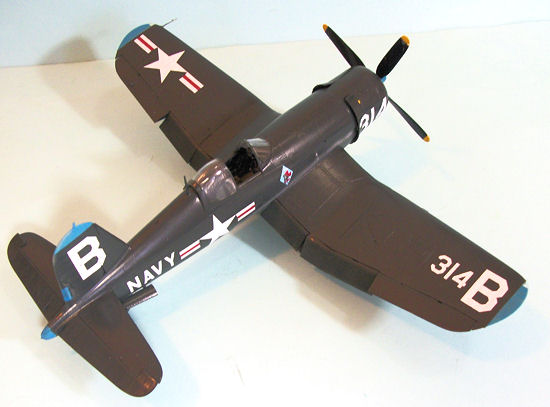 The Korean War
was where the F4U‑4 really shined.
Operated by both Navy and Marine squadrons from carriers ranging along the
Korean peninsula, as well as on land by the Marines, the F4U‑4 Corsair was in
action from the first day to the last of the war, providing the definition of
"close air support" to UN forces.
The Korean War
was where the F4U‑4 really shined.
Operated by both Navy and Marine squadrons from carriers ranging along the
Korean peninsula, as well as on land by the Marines, the F4U‑4 Corsair was in
action from the first day to the last of the war, providing the definition of
"close air support" to UN forces.
Most pilots who have flown the different versions of the Corsair rate the
F4U-4 as overall the best. The
F4U-5 that followed was not as successful, due to a number of technical changes
made in the operational system of the aircraft.
The F4U-4 gave the overall best performance in any role of any version of
the “Bent Wing Bird.”
VF-193 In The Korean War:
VF-193 “Ghost Riders” was a squadron of Air Group 19.
Based aboard U.S.S. Princeton, the air group entered Korean Combat
on November 4, 1950, just in time to provide cover for the 1st Marine
Division in the fighting retreat made from the Chosin Reservoir following the
intervention of the Red Chinese Army in the Korean War, an event then-Secretary
of State Dean Acheson called “The greatest defeat of American arms since the
Second Battle of Bull Run,” and which British historian Martin Gilbert described
as “the greatest defeat of a previously-victorious army in recorded history.”
While the U.S. Eighth Army in western Korea reeled under assaults from
the Chinese “volunteers” that came down out of the mountains in overwhelming
numbers, suffering over 50% of the total casualties the Army would lose in the
entire war, the 1st Marine Division, composed 80% of veterans of the Pacific War
and the cream of the Marine Corps, the division executed the greatest fighting
retreat against overwhelming numbers since Xenophon and the Ten Thousand Greeks
retreated from Persia. The Marines
lost 200 men per mile in the 10-day retreat to
Hungnam
in horrific winter weather conditions following the greatest blizzard to come
out of
Siberia
in a century just before the opening of the Chinese assault.
Of 7,400 casualties from a Division total of 15,000, 3,600 were due to
frostbite. The Chosin Campaign is
considered “The Corps’ finest hour.”
The Marines could never have made it without the total control of the air
provided by Marine and Navy units.
While Marine Corsairs operated from land bases, three fleet carriers of Task
Force 77 cruised 100 miles off the coast in the
Sea of Japan.
The carriers operated in heavy winter weather conditions, with operations
alternating with snowstorms that left flight decks covered in up to a foot of
snow that required an “all hands” effort to keep clear for operations.
Pilots were flying as many as four missions a day from dawn to dusk.
The heavy lifting was performed by the two Corsair squadrons aboard each
ship; in the case of Air Group 19, these squadrons were VF-192 and VF-193 “Ghost
Riders.”
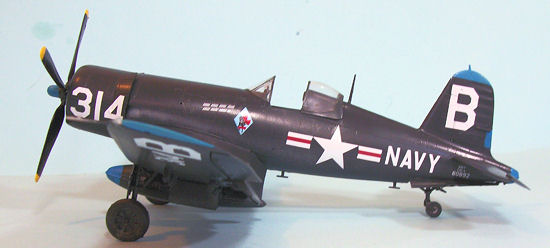 Between 1948, when the AD Skyraider was introduced to the fleet in
significant numbers and by the outbreak of the Korean War, the Navy had been busy
replacing F4U-4s with Skyraiders.
The Marines were able to benefit from this policy, taking all the
late-production F4U-4 and F4U-4B aircraft.
The Navy had to pull early-production Corsairs from the Naval Reserve to
equip fleet squadrons at full strength and call reserve squadron to active duty
to flesh out air groups in the face of wartime needs.
For pilots, the main difference between early and late production F4U-4s
was that the late production aircraft had a roomier cockpit due to having the
smaller F4U-1D type canopy replaced by one with a flat windscreen and a more
widely-bulged canopy, which improved pilot visibility. In terms of overall
performance, the aircraft were the same otherwise.
Between 1948, when the AD Skyraider was introduced to the fleet in
significant numbers and by the outbreak of the Korean War, the Navy had been busy
replacing F4U-4s with Skyraiders.
The Marines were able to benefit from this policy, taking all the
late-production F4U-4 and F4U-4B aircraft.
The Navy had to pull early-production Corsairs from the Naval Reserve to
equip fleet squadrons at full strength and call reserve squadron to active duty
to flesh out air groups in the face of wartime needs.
For pilots, the main difference between early and late production F4U-4s
was that the late production aircraft had a roomier cockpit due to having the
smaller F4U-1D type canopy replaced by one with a flat windscreen and a more
widely-bulged canopy, which improved pilot visibility. In terms of overall
performance, the aircraft were the same otherwise.
Following the extraction of the last Marines from
Hungnam
by December 17, as the UN lines stabilized south of the 38th
Parallel, the aircraft of Task Force 77 were put to work cutting the Communist
supply lines through
North Korea.
This was hard, dirty, unglamorous work, and it took its toll as the
Chinese became adept at
creating flak traps near important sections of rail lines and roads.
The carrier attack squadrons took casualties of around 35% during their
tours throughout the Korean War.
VF-193 and their sister squadrons VF-191, VF-192 and VA-195 flew tours of two
weeks in the
Sea of Japan
followed by ten days in
Japan
for replenishment until their tour was completed on
May 29, 1951,
by which time the Korean War had settled into the stalemate that would continue
until the end in July 1953. VF-193
and the sister squadrons returned of Air Group 19(B) returned a year later for a
second Korean tour on
March 21, 1952
flying combat until
November 3, 1952.
The Hobby Boss 1/48 F4U-4 Corsair is essentially a scale-down of the 1/32
Trumpeter kit released in 2003.
This early version has the early-style canopy with the rounded windscreen, and
the zero-length racks for eight HVARs under the wings, which is different from
the Trumpeter kit which is a late production F4U-4 with the flat windscreen.
There will most likely be a second release in 1/48 of the later version.
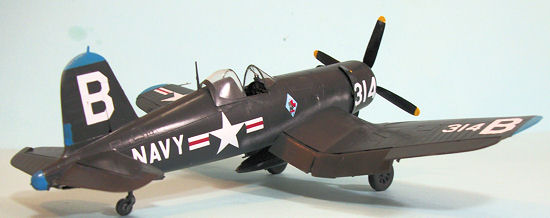 While the kit has several of the problems associated with the earlier
Trumpeter kit, these are easier to fix, and are not the “fatal mistakes” that
several of the “shoot first/aim later” crowd over at The World’s Greatest
Modeling Site have claimed it is.
The most obviously glaring mistake is the main gear wells, where the forward
section is not shaped correctly, which leaves the gear doors looking strange.
It takes probably a total of 10 minutes to correct the wing cutout and to
add a couple bits of plastic sheet to the gear doors to fix the shape error.
The molding of the fabric detail in the outer wings is not what modelers
expect from their exposure to the Tamiya Corsairs, but under a coat of Glossy
Sea Blue, this is only apparent from a range of less than six inches from the
model, a point of view which few of us view our models from.
While the kit has several of the problems associated with the earlier
Trumpeter kit, these are easier to fix, and are not the “fatal mistakes” that
several of the “shoot first/aim later” crowd over at The World’s Greatest
Modeling Site have claimed it is.
The most obviously glaring mistake is the main gear wells, where the forward
section is not shaped correctly, which leaves the gear doors looking strange.
It takes probably a total of 10 minutes to correct the wing cutout and to
add a couple bits of plastic sheet to the gear doors to fix the shape error.
The molding of the fabric detail in the outer wings is not what modelers
expect from their exposure to the Tamiya Corsairs, but under a coat of Glossy
Sea Blue, this is only apparent from a range of less than six inches from the
model, a point of view which few of us view our models from.
The decals are for two different Corsairs from circa 1948, rather than
from the Korean War. However, there
have been numerous aftermarket decal sheets released over the past 30 years for
Korean-era F4U-4s, and it’s likely most modelers have at least one or two in
their stash. The one thing to note
if one decides to do this kit as a Korean-era airplane is that such would only
be carrying U.S. Navy markings, since the Marines uniformly used the later
version F4U-4 in their squadrons.
Overall, construction of this model was about as hard as doing a Tamiya
Corsair model. Parts fit is
excellent; if you are careful in assembly, you may be able to get away without
having to use any seam filler, and if you are forced to use such it will be
minimal unless assembly was completely ham-fisted.
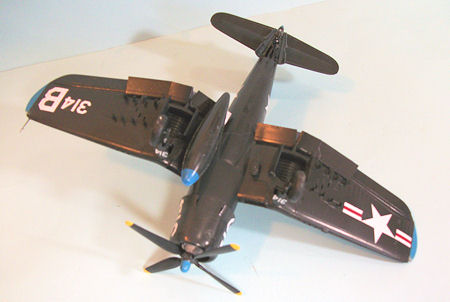 The folding wing option is similar to that of the Tamiya kits, and
spreading the wings should be done with some additional strengthening of the
joint with Evergreen strip inside for additional gluing surface.
The separate control surfaces are designed to be in the neutral position
with the flaps up, but it is not difficult to lower the flaps if one carefully
cuts off the forward part of each of the hinges on the lower flap surfaces.
Since the kit does not provide the fold-out pieces that cover the flap
area when the flaps are up, lowering the flaps is an easier option.
If you raise the flaps, you will need to use some Evergreen strip to
cover over those areas just forward of the flaps; this too is not hard to do.
The folding wing option is similar to that of the Tamiya kits, and
spreading the wings should be done with some additional strengthening of the
joint with Evergreen strip inside for additional gluing surface.
The separate control surfaces are designed to be in the neutral position
with the flaps up, but it is not difficult to lower the flaps if one carefully
cuts off the forward part of each of the hinges on the lower flap surfaces.
Since the kit does not provide the fold-out pieces that cover the flap
area when the flaps are up, lowering the flaps is an easier option.
If you raise the flaps, you will need to use some Evergreen strip to
cover over those areas just forward of the flaps; this too is not hard to do.
I assembled the horizontal stabilizers and elevators with the elevators
drooped a bit, mostly for looks, since most Corsairs on the ground have the
control surfaces in neutral.
I used the decal sheets for the instrument panels in the cockpit, and
also used some Eduard photoetch seatbelts.
The F4U-4 cockpit is overall black other than the forward bulkhead, floor
and aft bulkhead, which are interior green.
The engine is one of the most detailed 1/48 R-2800s I have ever seen,
with a full exhaust system. If you
pre-paint everything, none of this assembly is difficult.
You don’t really need the exhausts since you won’t see them, but the main
part of the exhausts is necessary for mounting the engine to the fuselage.
You must assemble the very fiddly tail wheel and hook before closing up
the fuselage.
I painted the prop hub, wingtips and rudder tip, and the rudder trim tab
with Tamiya “Sky Blue,” then painted the model overall with Xtracrylix Glossy
Sea Blue. I didn’t need a gloss
varnish, since these paints are all gloss.
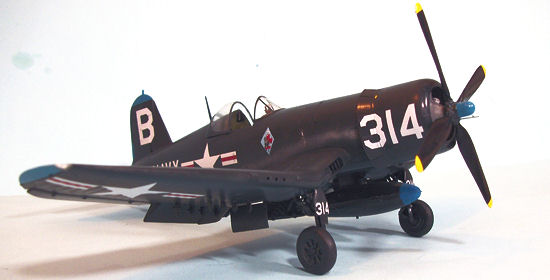
The Aeromaster decals, which I think were released somewhere around 1992,
performed perfectly with only a coat of Micro-Sol needed to get them to settle
down.
I applied some extensive exhaust staining with light grey applied under a
coat of Tamiya “Smoke” so the airplane looked as well-used as the photos I had
showed it was.
The main gear was attached, the canopy was unmasked and posed in the open
position. I haven’t decided yet whether or not to arm it with underwing
ordnance.
Unlike the naysayers, I think this is the best F4U-4 available at present
in 1/48. While it is not perfect,
its imperfections are either easily straightened out or ignored without further
effect. I would place the kit
second behind the Tamiya early Corsairs and ahead of the later Hasegawa Corsairs
in terms of overall kit design and fit, ease of assembly, and final look.
The kit is a bit “fiddly” but nothing that can’t be handled with “some
modeling skill required.” Highly recommended to those who like Corsairs and are
willing to put a tiny bit of effort into minor corrections.
Tom
Cleaver
October 2012
Thanks to me and the Squadron Mystery Deal
for the review kit.
If you would like your product reviewed fairly and fairly quickly, please
contact
the editor or see other details in the
Note to
Contributors.
Back to the Main Page
Back to the Review
Index Page
Back to the Previews Index Page


 The Korean War
was where the F4U‑4 really shined.
Operated by both Navy and Marine squadrons from carriers ranging along the
Korean peninsula, as well as on land by the Marines, the F4U‑4 Corsair was in
action from the first day to the last of the war, providing the definition of
"close air support" to UN forces.
The Korean War
was where the F4U‑4 really shined.
Operated by both Navy and Marine squadrons from carriers ranging along the
Korean peninsula, as well as on land by the Marines, the F4U‑4 Corsair was in
action from the first day to the last of the war, providing the definition of
"close air support" to UN forces. Between 1948, when the AD Skyraider was introduced to the fleet in
significant numbers and by the outbreak of the Korean War, the Navy had been busy
replacing F4U-4s with Skyraiders.
The Marines were able to benefit from this policy, taking all the
late-production F4U-4 and F4U-4B aircraft.
The Navy had to pull early-production Corsairs from the Naval Reserve to
equip fleet squadrons at full strength and call reserve squadron to active duty
to flesh out air groups in the face of wartime needs.
For pilots, the main difference between early and late production F4U-4s
was that the late production aircraft had a roomier cockpit due to having the
smaller F4U-1D type canopy replaced by one with a flat windscreen and a more
widely-bulged canopy, which improved pilot visibility. In terms of overall
performance, the aircraft were the same otherwise.
Between 1948, when the AD Skyraider was introduced to the fleet in
significant numbers and by the outbreak of the Korean War, the Navy had been busy
replacing F4U-4s with Skyraiders.
The Marines were able to benefit from this policy, taking all the
late-production F4U-4 and F4U-4B aircraft.
The Navy had to pull early-production Corsairs from the Naval Reserve to
equip fleet squadrons at full strength and call reserve squadron to active duty
to flesh out air groups in the face of wartime needs.
For pilots, the main difference between early and late production F4U-4s
was that the late production aircraft had a roomier cockpit due to having the
smaller F4U-1D type canopy replaced by one with a flat windscreen and a more
widely-bulged canopy, which improved pilot visibility. In terms of overall
performance, the aircraft were the same otherwise.

